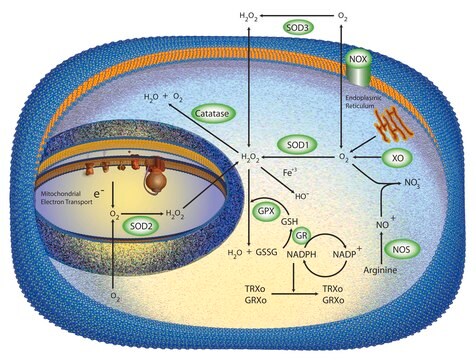추천 제품
생물학적 소스
mouse
Quality Level
결합
unconjugated
항체 형태
tissue culture supernatant
항체 생산 유형
primary antibodies
클론
GrB7, monoclonal
설명
not suitable for immunocytochemistry (frozen sections)
분자량
antigen 33 kDa
종 반응성
human
기술
immunocytochemistry: 1:20 using pretreated tissues
western blot: suitable
UniProt 수납 번호
배송 상태
dry ice
저장 온도
−20°C
타겟 번역 후 변형
unmodified
유전자 정보
human ... GZMB(3002)
특이성
Does not cross-react with granzyme A.
면역원
recombinant human granzyme B.
애플리케이션
Monoclonal Anti-Granzyme B antibody is suitable for western blot and immunocytochemistry at a dilution of 1:20 using pretreated tissues.
생화학적/생리학적 작용
Granzyme B, neutral serine protease, is expressed in cytoplasmic granules of activated cytotoxic T lymphocytes and natural killer cells. It contains a leader sequence (cleaved by a signal peptidase) and two amino acid prodomains (cleaved by the lysosomal cysteine protease DPPI). It plays a major role in the caspase dependent apoptotic pathway by activating most of the caspases in vitro and in vivo. It cleaves the aspartic acid residues, to facilitate cell death by various pathways. It has been shown that granzyme B has capacity to facilitate cytochrome C release from the mitochondria in a caspase independent way.
물리적 형태
Supplied in serum-free culture medium containing 1% bovine serum albumin and 0.1% sodium azide.
면책조항
Unless otherwise stated in our catalog or other company documentation accompanying the product(s), our products are intended for research use only and are not to be used for any other purpose, which includes but is not limited to, unauthorized commercial uses, in vitro diagnostic uses, ex vivo or in vivo therapeutic uses or any type of consumption or application to humans or animals.
적합한 제품을 찾을 수 없으신가요?
당사의 제품 선택기 도구.을(를) 시도해 보세요.
Storage Class Code
12 - Non Combustible Liquids
WGK
WGK 3
Flash Point (°F)
Not applicable
Flash Point (°C)
Not applicable
가장 최신 버전 중 하나를 선택하세요:
J A Kummer et al.
Journal of immunological methods, 163(1), 77-83 (1993-07-06)
The human serine proteases granzymes A and B are expressed in cytoplasmic granules of activated cytotoxic T lymphocytes and natural killer cells. Recombinant granzyme A and granzyme B proteins were produced in bacteria, purified and then used to raise specific
J A Heibein et al.
Journal of immunology (Baltimore, Md. : 1950), 163(9), 4683-4693 (1999-10-21)
CTLs kill targets by inducing them to die through apoptosis. A number of morphological and biochemical events are now recognized as characteristic features of the apoptotic program. Among these, the disruption of the inner mitochondrial transmembrane potential (Delta Psi m)
J J Oudejans et al.
Blood, 87(9), 3844-3851 (1996-05-01)
To get insight into the failure of the immune system to eradicate Epstein-Barr virus (EBV) harboring Hodgkin and Reed-Sternberg cells (H-RS cells), expressing the latent membrane protein 1 (LMP1), we analyzed major histocompatibility complex (MHC) class I expression on H-RS
S Shresta et al.
Current opinion in immunology, 10(5), 581-587 (1998-10-31)
CD8+ cytotoxic lymphocytes, natural killer cells and lymphokine-activated killer cells depend primarily on the perforin/granzyme system to kill their targets, while CD4+ T cells utilize Fas and other mechanisms to induce cell death. The molecular mechanisms used by these pathways
J A Trapani et al.
Immunology today, 20(8), 351-356 (1999-08-04)
Viral strategies for escaping apoptosis have co-evolved with the immune system, resulting in a complex balance of pro- and anti-apoptotic forces in virus-infected cells under attack by cytotoxic T lymphocytes (CTLs). Here, Joseph Trapani and colleagues argue that CTL cytolytic
자사의 과학자팀은 생명 과학, 재료 과학, 화학 합성, 크로마토그래피, 분석 및 기타 많은 영역을 포함한 모든 과학 분야에 경험이 있습니다..
고객지원팀으로 연락바랍니다.



